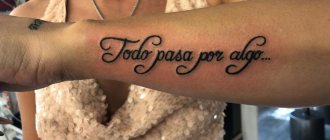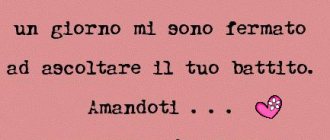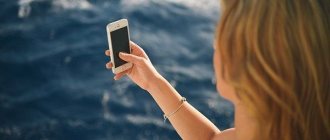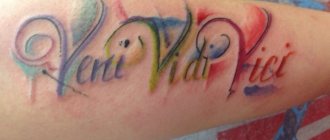Tattoo inscription in Arabic
Arabic inscriptions are a thin script font that looks like an exquisite pattern. The alphabet is among the ten most beautiful in the World. It is not surprising that Muslim tattoos are popular not only among supporters of Islam.
Using ducts, the master will recreate eastern wisdom or a wish for prosperity on the skin.
Some General Information about Arabic
The letters of the Arabic alphabet are similar to hieroglyphs. To create a tattoo, the written language of Islamic peoples, called ALYA, is used.
It is considered the official literary form and the Koran is written on it. The form used by tattoo artists was formed in the 7th century AD. e. Thus, Arabic is one of the youngest languages in the world.
Arabs read from right to left. This makes them similar to the Chinese and Japanese languages. There are 28 letters in the alphabet, half of which are long vowels and the rest are consonants. Short vowels are marked with vowels.
Common phrases for tattoos are based on the strokes “Ruk'a” or “Naskh”. The structure of handwriting is extremely important for Arabic writing. As in Japanese, the form of writing is addressed to sensory perception.
Arabic tattoos - meaning
Muslim tattoos are divided into signs and written phrases. Common symbols for drawings on the skin are the crescent moon, mosque, rosary, sword, Miriam's palm.
Lettering tattoos and their meaning:
- عِش اليوم وإنس الغد - live for today, forget about tomorrow;
- سامحني وحبني دائماً - forgive and love me always;
- جمال - beauty;
- حب - love;
- عائلتي - family;
- اجعل الله اولويتك - God is above all;
- كننفسك - to be yourself, to remain yourself.
Men prefer to strike a crescent with a star, as Muslims consider this symbol to be their coat of arms. Supporters of Islam choose symbols that reflect religious values.
Miriam's Hand is one of the protective symbols. This is the personification of maternal protection, the patronage of the prophet.* The palm is depicted in the form of a flower, which is filled with patterns.
*In Islamic countries, the Virgin Mary is revered as a prophet. Miriam is an Arabic reading of the saint's name.
How Islam views tattoos
The Islamic community is conservative, their views are close to the worldview of the 19th century. Orthodox Muslims consider marks on the body to be a sin. The prohibitions are based on scriptures from the Koran. They say that at the hour of the Last Judgment, Allah will ask for the mutilated body.
Accepted Islamic standards prohibit any modification of the body, as this is considered an intrusion into God's design for man. Religious leaders actively condemn any designs on the skin, since, in their opinion, this distorts human nature. The dogma expresses the idea “the body is the temple of the soul.”
Despite this, Arabic tattoos are increasingly appearing on the bodies of Islamic youth. Severe prohibitions do not deter boys and girls from decorating their skin.
Despite this, Arabic tattoos are increasingly appearing on the bodies of Islamic youth. Severe prohibitions do not deter boys and girls from decorating their skin.
A Muslim bodybuilder from Sydney has 80% of his body covered in tattoos. He became a hero for Islamic youth and a fighter against old ways. Regarding attacks from Orthodox Muslims, he replies: “Don’t dream of seeing changes in yourself if you don’t make them yourself!”
Symbols and meanings of Arabic tattoos
Ornate Arabic symbols occupy a huge place in the art of tattoos. The patterns decorating the body look very decorative, reminiscent of lace. Arab culture is characterized by floral ornaments with complex contours. The drawings are made thinly and on a large scale, occupying a certain part of the body. As a rule, such images are considered feminine and have a magical meaning, telling about the natural strength of the fair sex.
Often Arabic symbols serve as a tattoo as a talisman. They are designed to ward off evil spirits and attract good luck. In addition, the beauty of patterns has served to attract attention since ancient times. Drawings in the form of smooth lines were applied by the dancers due to the fact that they repeated the graceful movements of their hands during the dance.
Marvelous flowers and petals carry ritual symbolism. Women of the East still apply images in preparation for religious holidays. Temporary tattoos have the properties of talismans. Many of them bring happiness in marriage and are a symbol of eternal love.
Arabic pattern tattoo on forearm for men
Round Arabic chest tattoo for men
Men's tattoo in Arabic style on the inside of the arm
Temporary Arabic tattoo in the form of a floral design on the back of the hand for girls
Women's tattoo in Arabic style in the form of a flower on the forearm
Arabic tattoo on the lower back for a girl
Arabic tattoos do not have a specific pattern. They repeat various embroidery patterns and painting techniques characteristic of this people. The patterns on the body look like very complex patterns with many small details.
What does this tattoo give a man for self-affirmation?
In ancient times, when religion and prejudice were not yet so developed, tattoos were applied to bodies everywhere, and among Muslim peoples as well. Some tribes and countries traditionally applied body images to infants as amulets. The most ancient ideas are geometric shapes, intricate patterns and ornaments.
Why are such drawings needed today:
- protect yourself from temptations and evil;
- attract good luck and success to your destiny;
- emphasize belonging to Muslim peoples;
- create an emphasis on love for Eastern culture and traditions;
- express religious prejudices;
- demonstrate a mysterious and original style .
Places
There is no ideal place for an inscription - everyone chooses according to their taste. It is also important that the meaning of an aphorism or word corresponds to the place in which it is written. Please note that Arabic is the native language of a huge portion of the Middle Eastern population. These people have a high respect for their traditions. That is why, when using Arabic script as an element of a tattoo, be smart.
The wrong choice of location may cause misunderstanding in certain circles.
But we will still offer you several 100% proven places for an Arabic tattoo:
- Breast;
- Forearm;
- Neck;
- The area between the shoulder blades;
- Small of the back.
Arabic inscriptions with translation
In order not to make a mistake in your choice, inscriptions with translation can be taken from websites for learning the Arabic language. In the examples given, individual words and catchphrases are indicated. They are great for tattoos.
Lettering tattoo meaning:
- happiness in Arabic is written as - سعادة;
- the expression “save and preserve” - احفظ و احفظ;
- Love is not a bird kept in a cage - الجمال ليس عصفور فيقفص
- They were cunning, Allah was cunning, but Allah is the best of cunning people.
Quotes and aphorisms are especially loved; quotes from the Koran take first place in this list. In second place are the expressions of famous Sufis. Connoisseurs of witty expressions prefer the work of Hadji Nasreddin.
We recommend reading: Orthodox tattoos
Phrases for tattoos in Arabic: the attitude of Muslims to inscriptions
Some Muslim believers believe that tattooing the body is contrary to religion. And a tattoo with an inscription in Arabic is an even greater sin, since it is written in the language of the Koran. Because of this fact, many people avoid getting a Muslim tattoo because they do not want to offend the religion and its followers. However, over the years the situation has changed for the better, as new generations of young believers are less conservative and consider Arabic tattoos to be a beautiful decoration for the body.
Where do men most often get Islamic tattoos?
Islamic tattoos include several peoples and countries; these can be Tatar, Turkish, Azerbaijani and other symbols, inscriptions, styles. The location of the sketches can be different, from the neck to the feet. Each corner of the body has its own designation.
Shoulder
On the left shoulder it is customary to draw those sketches that are necessary for protection and bringing good luck into life. The right on the shoulder concerns wisdom, life priorities and values, love and family.
Forearm
If a man wants the tattoo to be always visible to those around him, Muslim motifs can be applied to the forearm area. The inscriptions will look especially advantageous when they are arranged elongated from top to bottom or in another direction.
Wrist tattoo
From ancient times to today, it has been customary to tattoo variants of tattoos on the wrist that will attract energy waves at an increased rhythm. There should be neat, laconic drawings of a personal nature.
Tattoos on the palm, hand and fingers
Especially often Muslim tattoo motifs in the format of inscriptions are found on the fingers. This could be a name or a phrase with deep meaning placed on the skin. Demonstrative tattoos are placed on the hands; on the palms, on the contrary, there are non-trivial personal options.
Tattoo sleeve
The coolest trend of recent years is a tattoo on the arm in a sleeve format, when the design covers the entire circumference of the skin, leaving no gaps or empty spaces. In this format, craftsmen can depict patterns and ornaments, complementing them with Islamic symbols, Arabic script and other inscriptions.
Neck
Any designs on the neck will look elegant and stylish. Most often, men use the side, applying inscriptions, small laconic symbols, patterns and even small ornaments here.
Breast
It is customary to wear tattoos on the chest that will help protect a person’s destiny from evil, dangers and failures. These can be patterns in Muslim traditions, to which the master can add symbolism, various objects, animal or plant patterns, and inscriptions.
Side
There is enough space on the side for large and complex sketches; there is a straight, smooth surface, and the applied drawings will be accessible only to the owner and his immediate environment.
Back
The back is the place where there are no limits to the realization of fantasies. You can apply absolutely any design here. The scale, color scheme, complexity and meaning are not important.
Spatula
In such places it is customary to print symbolic and sacred drawings, which will help pacify the dark side and get rid of weaknesses and temptations. Most often these are mystical and religious symbols, inscriptions, and patterns.
Leg
Ideas such as motivating and decisive inscriptions, as well as symbols that help you find the right path in life, will fit perfectly on your foot.
Arabic inscriptions: ideas for application
Most people use various services to translate texts in Arabic. But these programs, as a rule, carry out illiterate translation: in 90% of cases the phrase is grammatically incorrect or does not make sense. Therefore, an important point when choosing an Arabic tattoo is to find an artist who understands calligraphy and knows how to draw it in order to avoid misinterpretation in the future.
Arabic script looks impressive on any part of the body: it is a matter of personal choice. However, there are certain areas where a tattoo looks most attractive. For a poem or long phrase in Arabic, the chest, back, and ribs are best. However, many people prefer to have them tattooed on the shoulder, forearm, ankle or thigh.
The attractiveness and mystery of the ligature makes the meaning of the tattoo mysterious for people who do not know this language. This fact attracts tattoo owners who want to leave the meaning of the inscription unclear to most.
Numerals
| Phrase in Russian | Translation | Pronunciation |
| 0 | sipher | |
| 1 | wahid (wahad) | |
| 2 | itnan (itnin) | |
| 3 | talata | |
| 4 | arba-a | |
| 5 | hamiza | |
| 6 | sitta | |
| 7 | saba-a | |
| 8 | Tamania | |
| 9 | tizaa (tes-a) | |
| 10 | ashara | |
| 11 | hidashar | |
| 12 | itnaashar | |
| 13 | talattashar | |
| 14 | arba tashar | |
| 15 | Hamas Ta'ashar | |
| 16 | sittatashar | |
| 17 | sabataashar | |
| 18 | taman tashar | |
| 19 | Tiza Tashar | |
| 20 | isrin | |
| 21 | Wahid wa Ashrin | |
| 22 | itnan va ashrim | |
| 30 | talatin | |
| 40 | arbaain | |
| 50 | khamsin | |
| 60 | sitin | |
| 70 | sabba-in | |
| 80 | tamanin | |
| 90 | tiza-in | |
| 100 | mia (meya) | |
| 200 | mithein | |
| 300 | talatmeya | |
| 400 | arbameya | |
| 500 | hamsameya | |
| 600 | sittameya | |
| 700 | sabameya | |
| 800 | tamanimeya | |
| 900 | tisameya | |
| 1 000 | alpha | |
| 2 000 | alfen | |
| 3 000 | talattalaf | |
| 100 000 | mit alf | |
| 1 000 000 | million-an |
In the shop
| Cigarette | Cigar | سيجارة |
| Cigar | Cigar | سيجار |
| Juice | Asyr | عصير |
| Tomato juice | Asyr uta, asyr tomato | عصير طماطم. |
| Bag | Shanta | حقيبة |
| Towel | Photo | منشفة |
| Shop | Makhzin | متجر |
| Fish | Samak | سمك |
| Gold | Dehab | الذهب |
| Chain | Selseya | سلسلة |
| Water | Mayan | ماء |
Emergencies
| Phrase in Russian | Translation | Pronunciation |
| Police | الشرطة | shurta |
| Ambulance | سيارة إسعاف | isaaf |
| Hospital | المستشفى | mostashifa |
| Pharmacy | صيدلية | sidelia |
| Doctor | طبيب | tabib |
| I'm sick / I'm sick | Ana marId / Ana marIda | |
| injury, wound | jArah | |
| blood | I'll give | |
| temperature | harAra | |
| sunstroke | dArbat shYams | |
| diabetes | sUkkari | |
| allergy | Khasasiya | |
| asthma | Azma | |
| pressure | dAgat |
What Chinese characters look like, how to distinguish them from Japanese, Korean, etc.
For a non-professional or someone who does not know any of these languages, it is almost impossible to distinguish between them. If you really want to distinguish, at least visually, then you can listen to a few tips:
- The Hangul alphabet is Korean. It is characterized by a large number of circles and ovals. Straight lines are also often used. For example: 사, 기쁨, 운, 세계, 헌신, 충, 인내. The Korean language is more expansive than Chinese and Japanese.
- To find a text in Japanese, you need to remember its three main elements, which are called katakana, kanji, higarana. Many characters in Japan are also round, but they are characterized by a slight carelessness in writing. An example is the Japanese characters: 愛, 喜び, 運がいい, 世界, 献身, 慊つキツ。, 我慢. When recognizing the Japanese language, take into account that some characters were taken from Chinese, and they, in turn, are more encrypted and complex.
Tattoos in Arabic and their meanings
The Attractiveness of Arabic Tattoos
Recently, more and more people are putting tattoos on their bodies with an inscription in Arabic . The reason for this is that the Arabic language with its script is considered exotic, mysterious, and beautiful. Therefore, when a person gets a tattoo in Arabic, it is believed that he is taking on this exoticism and mystery. The same can be said about tattoos in Chinese or Hindi, for example.
For others, tattoos with Arabic designs have their own special meaning - love for Arab culture or Arab origin. Perhaps your passion for the Arabic language awoke after visiting Egypt, Morocco or other Arab countries.
Others simply love the elegance of Arabic writing and the way the letters are beautifully woven into words.
Below are some Arabic words and inscriptions for tattoos :
Angelina Jolie tattoo in Arabic: means "determination"
Rihanna's tattoo in Arabic: “Freedom in Christ”
Pay attention to the differences in writing systems
In Arabic, letters are written differently than, for example, in Russian. Ignorance of this can lead to serious confusion and disastrous mistakes that could have been easily avoided.
Here are some general rules:
– Arabic letters are written from right to left , not left to right. If you try to write Arabic letters from left to right, you will end up with a bunch of meaningless characters that native speakers cannot understand.
– Arabic letters, as a rule, are “connected” with adjacent letters in the word. This gives the letter an elegant and fluid appearance. This is similar to handwriting in Russian or other European languages: the letters are connected to each other so that they are written faster. The difference, of course, is that Arabic is ALWAYS written this way. If you do not connect the letters correctly, the resulting words will look very ugly in the eyes of those who speak the language. (Note, however, that there are a small number of letters that do not join on the left.)
Do not trust unreliable sources when choosing an inscription for a tattoo . I have seen many people come to me with a tattoo design supposedly done for them by their “native speaker” friends, but in reality it turned out that they barely speak Arabic and have a vague understanding of the rules of spelling and grammar.
If you receive an electronic copy of an Arabic tattoo design that you like, make sure it is in image or PDF format. It’s better to leave it as is and not try to get text from the inscription on the picture. The fact is that some editors are not configured properly to display Arabic characters and you may end up with crappy text instead of text. This will not happen with image files or PDF documents.
Here are some more ideas for Arabic tattoos:
"Faith, hope, love" tattoo in Arabic
Your name in Arabic
Many people want to get a tattoo of their name or their boyfriend/girlfriend's name. There are several "correct" ways to transliterate names in Arabic , so don't be surprised if you see several alternative spellings, depending on who you ask. This is why it is extremely important to choose a design with someone who can figure out which options are the most common, or most suitable for spelling your name.
Some general information about Arabic:
How does Islam view tattoos?
First of all, we need to be clear: not everyone who speaks Arabic is Muslim. There are many Arabs who are Christians, Jews, or atheists. Like all other languages, Arabic itself is not a religious language.
Conservative Muslims generally do not like tattoos of any kind on the body. As a rule, there are two reasons for this: firstly, they believe that they should refrain from causing any harm to their own body. And secondly, they believe that tattoos are associated with pagan rituals of idol worship. Islam (like other religions) has many sects within it, and there are many Muslims who have no problem with tattoos. The same is the case with conservative Christians and Jews who are against tattoos.
The point is, as long as you don't put something offensive on your skin, most religious people probably won't care one way or the other. Therefore, it is best not to tattoo verses from the Koran or sayings of the Prophet on the body.
What to do after you've chosen a design
Once you have found a design you like and are confident that the translation is correct, you need to take your sketch and contact a tattoo artist to discuss the details. Ideally, the artist should already have some experience in applying Arabic tattoos . If finding such a person is too difficult, try asking the tattoo artists themselves. Make sure the person understands the writing (top, bottom, right to left or left to right). Otherwise, there is a risk of getting a mirror image of the original on your skin.
Of course, choosing the right artist is also important.
– Visit a few studios and talk to the people who work there to get a general idea of their experience. This will also give you the opportunity to see and understand what kind of work they do, how clean the salon is, and check samples of their previous work.
– Do not give in to the temptation to immediately “get” a tattoo at every opportunity. You have the right to think carefully about your decision and choose the right artist.
– Look at the previous work done by the artist. Even if you are going to get a tattoo for the first time, you don't need to be a professional to understand whether the tattoo was done well or not.
– Ask friends who already have tattoos to give you recommendations, tell you which tattoo artist is good and which is not.
Where else can you get ideas for Arabic tattoo designs?
You can find someone who is a native speaker of Arabic or speaks it professionally. If done correctly, Arabic tattoos will decorate your body and attract the attention and glances of people around you. Just remember the important points described above so that you can enjoy your tattoo for many years to come.
Source
“Masha Allah”: how to spell it
This phrase is written like this: “هَذَا مَا شَاءَ اللهُ.” If we take a closer look, we get the following:
| Part | Writing | Translation |
| Haza | هَذَا | An unpronounceable particle that translates as “this” |
| Ma | مَا | Translated as “something that” (in this case we are talking about what Allah wanted) |
| Shaa | شاء | Want |
| Allah | الله | Name of the Almighty |
Can be mixed
Not all Arabic tattoos have to be drawn in a strict order. Large and colorful, the tattoo located later in the article is translated from Arabic as “princess”. It contains a Celtic style cross and a sun behind. Two different cultures and styles intertwine to form a very beautiful pattern. The script is completed with bright orange and yellow, symbolizing the sun.
Questions
| How are you? - How are you? | Zaye ssakha? - Zaye ssakha? | كيف حالك ؟ — كيف حالك ؟ |
| What is this? | Ed? | ما هذا ؟ |
| Who is this? | Me haza? | من هو هذا ؟ |
| Why? | Le? | لماذا؟ |
| Where? | Fin? | أين؟ |
| How? | Ezzay? | كيف؟ |
| Where are you going? | Raiha fin? | إلى أين أنت ذاهب ؟ |
| What is the price? | Beckem? | كم؟ |
| Do you have water? | Andak Maya? | هل لديك الماء؟ |
| Do you have a pen? | Andak alam? | هل لديك قلم ؟ |
DIY Muslim amulet
We have written a lot about the power of Arabic words, but we should mention another type of amulets that are popular among Muslims. The magic of knots is very popular among Arabs. Muslim talismans from threads can be easily made independently if you have certain weaving skills. Since ancient times, it was believed that eastern women, with the help of knot witchcraft, could change fate and attract good luck.
It is interesting that knots were knitted for protection not only in the East. The ancient Slavs also used knot magic - nauz.
A thread amulet helps against damage and evil fate. It is tied on the left ankle. To make such a talisman, take two threads, black and white. Intertwine and tie exactly one hundred and fourteen knots. This is the number of suras in the Koran, it is sacred to Muslims. When you weave, recite Surah “Bakara”.
A Muslim amulet for good luck in personal life is made from green and red threads. They should also be braided and tied into 114 knots and worn only under clothing. A home talisman for good luck is woven from three blue threads and two white ones, and then hides in a remote nook. Three green and one yellow thread will bring good luck in any endeavor.
Notes
- Ali-zade, A. A., 2007.
- al-Bukhari
Zabaih, chapter 25;
Muslim
Side, Hadith 58;
Ahmad ibn Hanbal
Musnad. T. 3, hadith 171 - ↑ 123456
Encyclopaedia of Islam, 1995, p. 685. - al-Bukhari Manqib al-ansar, chapter 27; Ayman, chapter 17; Muslim
Iman, hadith 176. - Garden [koran.islamnews.ru/?syra=38&ayts=17&aytp=17&kul=on&orig=on&original=og1&dictor=8&s= 38:17]
- Al-Ahqaf [koran.islamnews.ru/?syra=46&ayts=35&aytp=35&kul=on&orig=on&original=og1&dictor=8&s= 46:35]
- Al-Qasas [koran.islamnews.ru/?syra=28&ayts=54&aytp=54&kul=on&orig=on&original=og1&dictor=8&s= 28:54]
- Az-Zumar [koran.islamnews.ru/?syra=39&ayts=10&aytp=10&kul=on&orig=on&original=og1&dictor=8&s= 39:10]
- Al Imran [koran.islamnews.ru/?syra=3&ayts=142&aytp=142&kul=on&orig=on&original=og1&dictor=8&s= 3:142]
- Al-Anfal [koran.islamnews.ru/?syra=8&ayts=65&aytp=65&kul=on&orig=on&original=og1&dictor=8&s= 8:65]
- Yusuf [koran.islamnews.ru/?syra=12&ayts=18&aytp=18&kul=on&orig=on&original=og1&dictor=8&s= 12:18]
- Al-Baqara [koran.islamnews.ru/?syra=2&ayts=45&aytp=45&kul=on&orig=on&original=og1&dictor=8&s= 2:45]
- Al-Baqarah [koran.islamnews.ru/?syra=2&ayts=153&aytp=153&kul=on&orig=on&original=og1&dictor=8&s= 2:153]
- Ibrahim [koran.islamnews.ru/?syra=14&ayts=5&aytp=5&kul=on&orig=on&original=og1&dictor=8&s= 14:5]
- Encyclopaedia of Islam, 1995, p. 686.
Styles and colors that are popular for Muslim-style tattoos in 2018-2019.
The style of execution can radically change both the appearance and visual perception of the body design. The following options apply to Muslim ideas:
dot work – dot execution, ornaments look coolest in this style;
b lack work – the master uses only black paint, this option accepts inscriptions, symbols, as well as patterns and ornaments;
ornamental - Polynesian style, in which patterns and ornaments can also be depicted;
geometry - clear lines, simple and complex figures that form intricate patterns and symbols;
realism - in this style you can draw any tattoos, resulting in a believable sketch in comparison with the original;
3D - dimensional images that create the illusion of perception of space.
Most often, the Muslim style practices monochrome tattoos, where the use of gloomy monochromatic sketches predominates. Colored tattoos for men are very rare; creative, expressive, young and extraordinary guys make this choice.
Symbols on state flags
The sword depicted on the flag of Saudi Arabia is the famous sword passed down from Muhammad to Ali, and then to the latter’s son, who died in battle and made the forked blade a symbol of Shiite honor.
The main colors of Arab culture are red, green, white and black, which is reflected in the flags of states. For example, the flag of the United Arab Emirates includes all four colors: green symbolizes Islam, white symbolizes social values and nobility, black symbolizes deliverance from external violence and mourning for the fallen warriors of Islam, red symbolizes the strength of the nation.
All four pan-Arab colors are also used on the flag of Egypt, where you can also see the Arabic symbol of “Saladin’s eagle” - a heraldic figure, a sign of Arab nationalism, as well as on the flags of Iraq, Kuwait, Palestine, Syria, Sudan. Three colors are used on the banners of Algeria, Yemen, Lebanon, Oman.
Tattoo inscriptions in Arabic: photos of works
When applying a tattoo, you should not limit yourself to using just one word in Arabic. Calligraphy looks amazing, so you can use it to write long wise phrases, aphorisms, sayings, poems, etc.
Signs that carry wisdom look harmonious with any artistic solution. As a result, the Arabic inscription is printed not only in black: it looks stylish in different colors.
You can add bright colors to tattoo inscriptions: this will make them even more fashionable, and also breathe life into simple hieroglyphs.
Arabic symbols written in white ink look great on people with dark skin. In addition, the popularity of white tattoos has been steadily growing over recent years.
A special style of writing calligraphy is the famous Nastaliq design, where the words of a phrase or the letters of a word are written in a circle. This gives the tattoo an original look.
Geometric figures
The word "Allah" is written in the form of four vertical strokes, which, when written in the form of a square, began to symbolize the sacred house - the Kaaba. The square is generally one of the central figures in Arabic ornament. An eight-pointed star is also often found, representing the intersection of two squares at an angle of 90 degrees.
The triangle has the meaning of "the eye of God", and the pentagon symbolizes the five pillars of Islam.
While it may seem impossible to a foreigner to translate Arabic symbols embedded in intertwined patterns, educated Arabs can “read” the pattern almost like the pages of a book.
One word to describe it all
Why not use Arabic script instead of Chinese character? The Arabic tattoo, translated as “traveler,” indicates that a person loves to travel, loves nature, and strives to explore the world. He does not stand still, he is in constant motion. In Arabic sources, the journey is not only physical, but also spiritual.
Color symbolism
The color red in Islam is positioned as sacred and giving energy, and is associated with strength - both vital and physical. However, there are unspoken restrictions on its use: for example, men are prohibited from wearing red clothing. The only exceptions are holidays, when individual red elements are allowed. Interestingly, there is no direct prohibition on wearing such clothing in the Koran.
Blue and purple in Arab culture are given a mystical character. These are the colors that accompany a person on his path to God, accompanying acts of contemplation, reminiscent of the fact that everything earthly is transitory. Light blue and light blue are colors that can almost always be seen in the decoration of a mosque dome. This is the color of the sky, designed to calm and inspire confidence in parishioners in their choice to serve God.
Gray and brown are considered “bad” colors in Arab culture. They are associated with misfortune, evil, death, destruction, lowliness.
A number of Arabic symbols associated with flowers were borrowed from Roman and later European culture. For example, white is the color of purity, green is the color of nature. In addition, green is the color of Islam.
Arabic phrases
Alhamdulillah is a ritual prayer exclamation, an interjection expression used in Arab and other Muslim countries to praise Allah. In Arab countries it is also often used by Jews and Christians. Close in origin and meaning to the Jewish and Christian doxology Alleluia. Initially, it was believed that the phrase Alhamdulillah should be pronounced with a feeling of love, worship and admiration before the power, glory and mercy of God.
However, it is often used in everyday life in situations similar to those when Russian speakers say “Glory to God!” hears “may Allah have mercy on you” - “yarhamukya(ki)-Allahu”) As an answer to the question about how things are (in this case, equivalent to “Thank God, good”). As an answer to the question: “Are you a Muslim? » (in this case equivalent to “Glory to God, Muslim”). Koran[edit | edit source text] The phrase Alhamdulillah is found in the Quran, being the first words of the Quran after the basmala.
Basmala, bismillah, is an Islamic term for the phrase with which each sura of the Quran begins, except the ninth: “in the name of Allah, the Gracious, the Merciful” (Arabic: bi-smi-Llahi-r-rahmani-r-rahim).
It is said in every prayer, before the start of any important task, and many other documents drawn up by Muslims (letters, contracts, appeals, wills, etc.) usually begin with it. Eid Mubarak (Arabic - blessed holiday) - Islamic holiday greeting phrase in Eid al-Adha and Eid al-Adha.
For Arabs, the “Eid Mubarak” greeting is a universal greeting for any holiday and is an analogue of the Russian greeting “Happy Holiday!”
Inshallah, also inshallah, (Arabic in šāʾAllāh, “if God wills”, “if (it is) God’s will”; Turkish İnşallah; Mal., Indonesian. Insya Allah, abjadiyya - 418) - a ritual prayer exclamation, an interjection used in Arab and other Muslim countries as a sign of a Muslim's humility before the will of Allah.
- Accompanies the believer's statement about his plans or events that should happen in the future. In Arabic-speaking countries it is used by representatives of all faiths. In modern Arabic, it actually acts as a marker for the future tense. Roughly equivalent to the Russian “God willing!”, “With God’s help!”
- Can also indicate a desire for something to happen or a hope for blessing from God in some future endeavor. Sometimes said as a polite refusal, in response to a question or request that is difficult or impossible to fulfill. In Arab countries, it is considered impolite to refuse directly by saying “No.”
- In such cases, Inshallah can roughly mean, “What you ask of me is unfortunately not possible unless God intervenes.” [1] The expression goes back to the Koran, where in Surah Al-Kahf 23, 24 it is written: “And never say: “I will do it tomorrow,” (but say:) “Unless Allah wishes it!”
Mashallah, also mashallah, (Arabic.
mā šāʾAllāh, “what God wanted”, “it was God’s will”) is an Arabic ritual prayer exclamation, an interjection expression often used in Arab and other Muslim countries, as a sign of amazement, joy, praise and gratitude to God and humble recognition that everything happens according to the will of Allah. Usually pronounced immediately after receiving good news. Also used as a talisman phrase before the evil eye when pronouncing positive statements, praise, approval, admiration for something or someone (for example, after comments about the healthy appearance of a newborn). It is believed that through such ritual devaluation of virtues one can avoid envy and the evil eye. In Russian culture it roughly corresponds to the phrase “Glory to God!” or praise like “Well done!”
Source: https://sbitnevsv.livejournal.com/804441.html
Different
| I have water. | Ana andi maya. | لدي الماء. |
| I don't speak Arabic. | Ana mabat kallimsh arabi. | Well done. |
| I speak Arabic | Ana Beth Kallim Arabi | وأنا أتكلم العربية |
| a little | seamstress | قليلا |
| I don't understand. | Ana (mish) fahem/fahma. | أنا (لا) فهم. |
| Everything is fine? | Kulyu tamem? | هل أنت بخير ؟ |
| Everything is fine. | Kulyu tamem. | كل شيء على ما يرام . |
| I love you. | Ana backbek enta/enti. | أنا أحبك. |
| Me too. | Ana Komen. | ولا أنا. |
| Driver please | Yarais, min fadpack, | السائق، يرجى |
| stop here. | Han's camp | تتوقف هنا . |
| Is it true? - Is it true. | Wallahi. | حقا ؟ — صحيح . |
| Break | Raha | استراحة |
| House | Manziel bate | منزل |
| Apartment | Sha-a | شقة |
| Room | Oh yeah | غرفة |
| Pharmacy | Saidaleya | صيدلية |
| Village | Korea | قرية |
| Expensive | Gali | غاليا |
| A little bit, a little bit | Shwaya-swaya | قليلا |
| So-so | Nose-so-nose | مش بطال |
| Completely, everything, entirely... | May-may | تماما، كل تماما … |
| Too much, too much | Ktir | الكثير أيضا |
| Enough is enough | Halas | كفى |
| Never | Halas | أبدا |
| 0'K! | Pssah! | 0'K! |
| (Don't know | (Mish) erif/harp | (لا) أعرف |
| Drunkard | Sakran(s) | سكير |
| Hookah | Shisha | الشيشة |
Basic Phrases
| What is your name? | Esmak/esmik e? | ما اسمك ؟ |
| My name is … | Esme... | اسمي … |
| I'm from Russia. | Ana man Russia. | أنا من روسيا. |
| What would you like? | Aiz/aisa e? | ماذا تريد ؟ |
| I want juice | Aiz/ayza asyr. | أريد عصير |
| I want to eat | Aiz/aiza akl. | أريد أن آكل |
| I want to sleep | Aiz/aiza enem. | أريد أن أنام |
| I don't want… | Mish aiz/aiza... | أنا لا أريد … |
| Welcome! | Ahlan wasaylan! | نرحب مرة أخرى! |
| Hello! | Salam alaikum! | مرحبا ! |
| Good morning! | Sabak elher! | صباح الخير ! |
| Good evening! | Masa elher! | مساء الخير! |
| Goodbye! | Mae salama! | وداعا ! |
| Thank you. -You're welcome. | Shukran.-Afuan. | شكرا. الرجاء . |
| Please,… | Min fadlak/fadlik. Liao sanakht. | من فضلك… |
| Yes. | Ayua. | نعم. |
| No. | La-ah. | لا. |
| No. | Mafish. | لا. |
| Can | Mumkin | يمكن للمرء |
| It is forbidden | Mish mumkin | ممنوع |
| Fine | Kvaes/kvaesa. Hallua. | جيد |
| No problem! | Mafish nishakl! | لا مشكلة! |
| No problem! | Mish muskel! | لا مشكلة! |
| I'm tired/tired. | Ana taben/tabena. | أنا متعب / استنفدت. |







